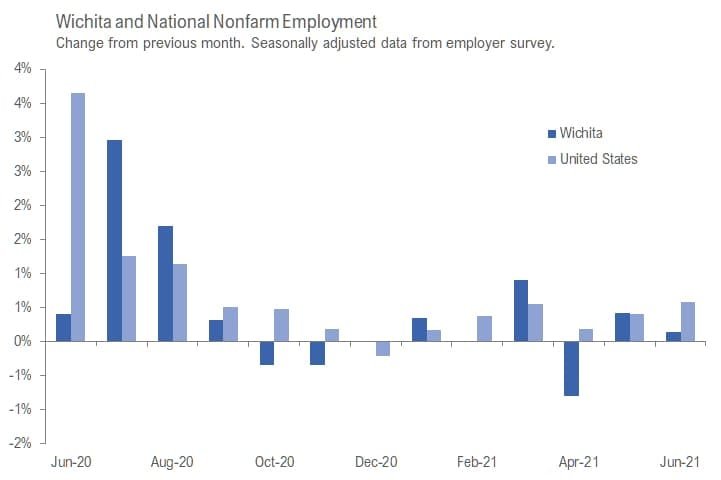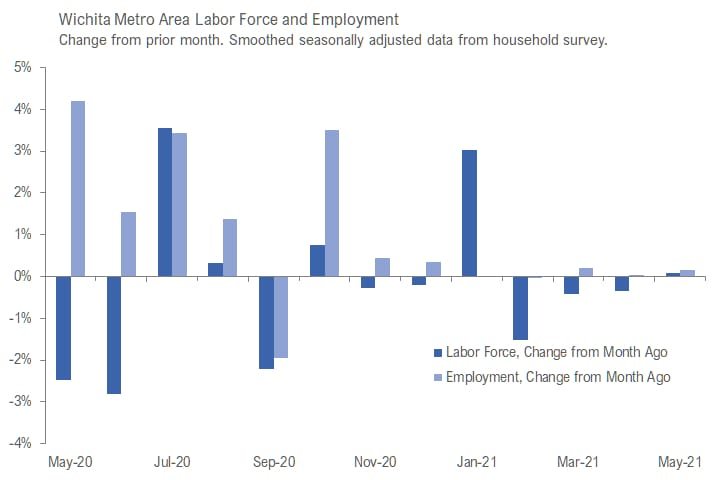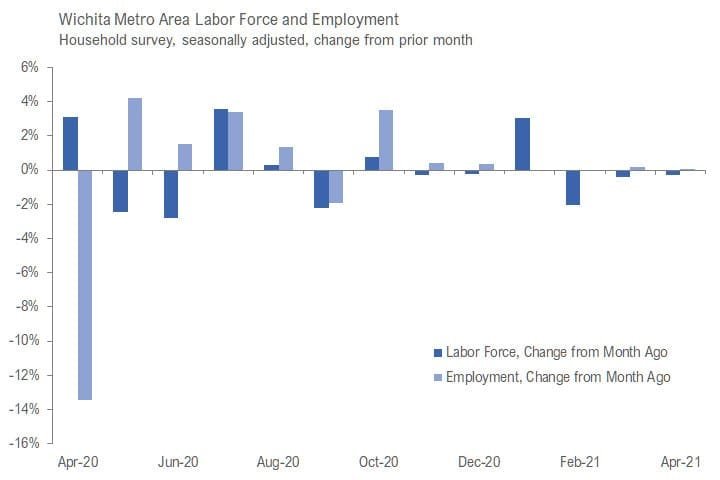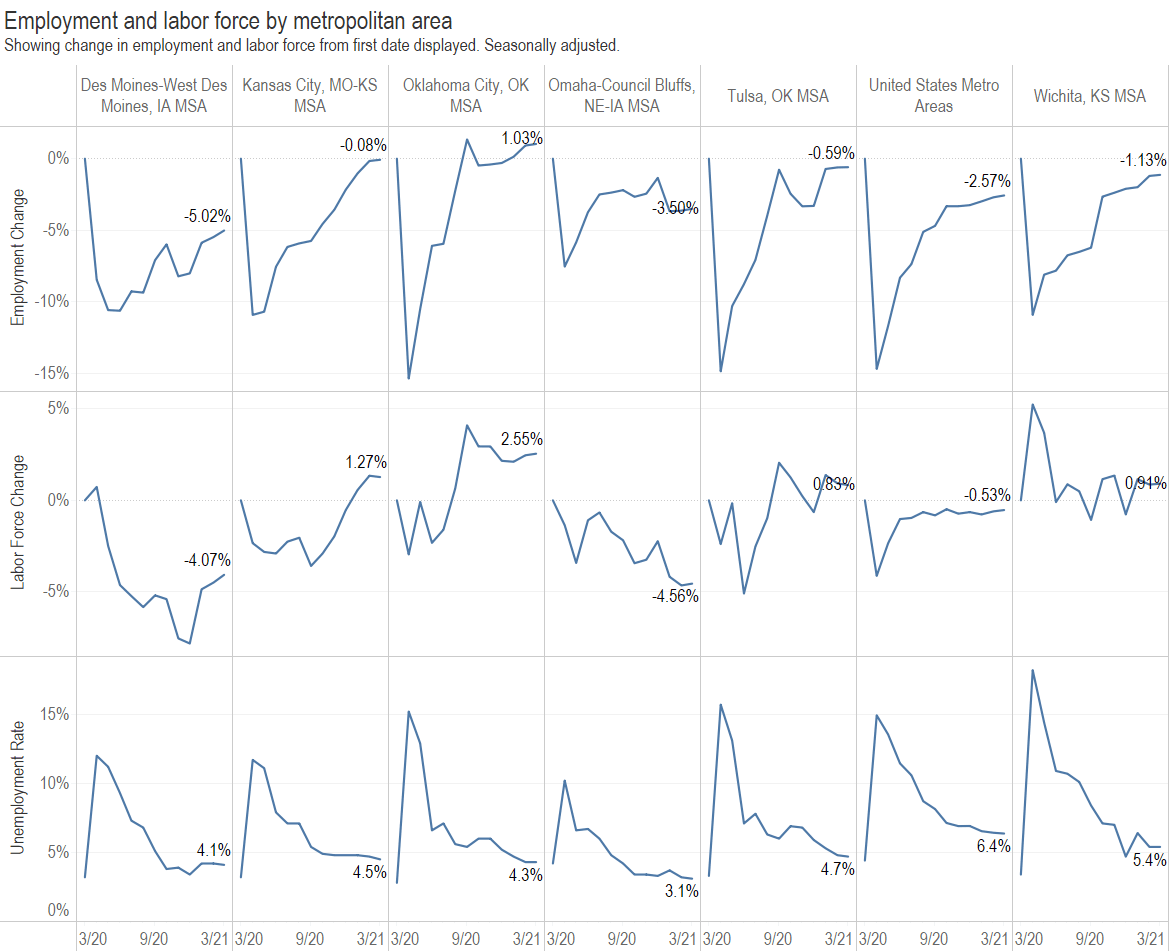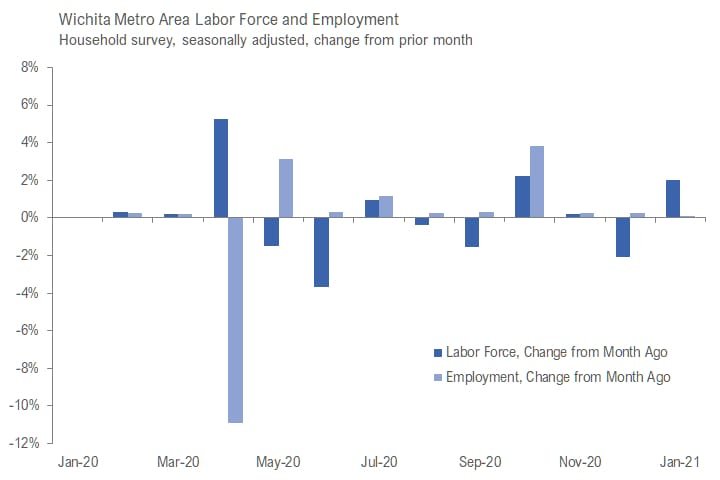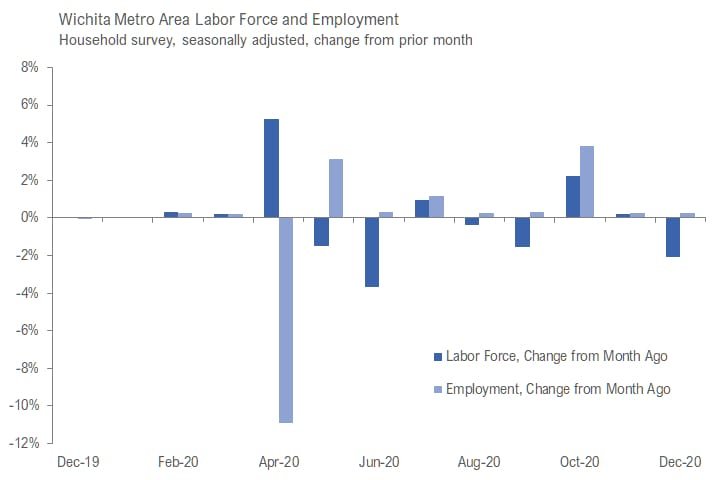For the Wichita metropolitan area in June 2021, the number of unemployed persons is down, the unemployment rate is down, and the number of people working is up when compared to the same month one year ago. The recent trend is showing smaller changes. (more…)
Tag: Economic development

Wichita employment situation, May 2021
For the Wichita metropolitan area in May 2021, the number of unemployed persons is down, the unemployment rate is down, and the number of people working is up when compared to the same month one year ago. The recent trend is exhibiting only small changes. (more…)

Wichita employment situation, April 2021
For the Wichita metropolitan area in April 2021, the number of unemployed persons is down, the unemployment rate is down, and the number of people working is up when compared to the same month one year ago. The recent trend is exhibiting only small changes. (more…)

Wichita since the start of the pandemic
How has Wichita fared since the start of the pandemic compared to other metropolitan areas?
(These examples are taken from my interactive visualization which holds data on all metropolitan areas in the nation. See Metro area employment and unemployment. It is updated through March 2021.)
The first chart shows Wichita and other Kansas metropolitan areas, as well as the total for all metropolitan areas. It shows changes in the number of jobs and the number of people in the labor force since the first month shown. It also shows the unemployment rate.
Click charts for larger versions.
As we can see, Wichita, in terms of employment, has done better than some, but also not as well as some.
A second chart shows Wichita along with some nearby metropolitan areas. Again, some have performed better than Wichita, and some not as well.
For comparison, here is the same chart of Wichita and the same metropolitan areas for the past 20 years. Wichita’s slow growth over these two decades is evident. Interestingly, Wichita has fared better since the start of the pandemic than some, notably Des Moines and Omaha as well as all U.S. metro areas.
As always, you may use the interactive visualization to create your own charts and tables. The link is above.

Wichita jobs and employment, March 2021
For the Wichita metropolitan area in March 2021, the number of unemployed persons is up, the unemployment rate is up, and the number of people working is down when compared to the same month one year ago. The recent trend is exhibiting only small changes.
Data released by the Bureau of Labor Statistics, part of the United States Department of Labor, shows the effects of the response to the pandemic in the Wichita Metropolitan Statistical Area for March 2021.
Click charts and tables for larger versions.
Total nonfarm employment fell from 306,200 in March 2020 to 287,600 in March 2021, a loss of 18,600 jobs (6.1 percent). (This data is not seasonally adjusted, so month-to-month comparisons are not valid.) For the same period, employment in the nation fell by 4.4 percent. The unemployment rate in March 2021 was 5.3 percent, up from 3.9 percent the same month one year prior.
Considering seasonally adjusted data from the household survey, the labor force rose by 145 persons (0.0 percent) in March 2021 from February 2021, the number of unemployed persons fell by 83 (0.5 percent), and the unemployment rate was 5.4 percent, unchanged from February. The number of employed persons not working on farms rose to 303,866 in March from 303,638 the prior month, an increase of 228 persons (0.1 percent).
The following chart of the monthly change in the labor force and employment in Wichita shows the magnitude of the drop in employment in April 2020 overwhelming other months, and then both positive and negative changes in employment for the following months. The rate of change is generally small except for October. The number of people in the labor force has both grown and shrank.
The following chart of changes from the same month one year ago shows a similar trend — fewer jobs, although the difference has become smaller as more people return to work.
The following chart of changes in employment from the same month of the previous year shows the Wichita MSA has mostly tracked the trend of the nation since the pandemic. In months affected by the pandemic, we see the initial loss in employment Wichita was not as severe as the nation. That is not the case in recent months.
The following chart shows the monthly change in nonfarm jobs for Wichita and the nation. Since September, the changes have been relatively small, with gains and losses.
The following two charts show changes in jobs for Wichita and the nation over longer periods. The change is calculated from the same month of the previous year. For times when the Wichita line was above the nation, Wichita was growing faster than the nation. This was often the case during the decades starting in 1990 and 2000. Since 2010, however, Wichita has only occasionally outperformed the nation and sometimes has been far below the nation.
(For data on all metropolitan areas in the nation, see my interactive visualization Metro area employment and unemployment. It is updated through March 2021.)
The link to the archived version of the BLS news release for this month may be found here.

Wichita jobs and employment, February 2021
For the Wichita metropolitan area in February 2021, the number of unemployed persons is up, the unemployment rate is up, and the number of people working is down when compared to the same month one year ago. The recent trend is more positive.
Data released by the Bureau of Labor Statistics, part of the United States Department of Labor, shows the effects of the response to the pandemic in the Wichita Metropolitan Statistical Area for February 2021.
Click charts and tables for larger versions.
Total nonfarm employment fell from 306,700 in February 2020 to 282,300 in February 2021, a loss of 24,400 jobs (8.0 percent). (This data is not seasonally adjusted, so month-to-month comparisons are not valid.) For the same period, employment in the nation fell by 5.9 percent. The unemployment rate in February 2021 was 6.4 percent, up from 3.8 percent the same month one year prior.
Considering seasonally adjusted data from the household survey, the labor force fell by 212 persons (0.1 percent) in February 2021 from January 2021, the number of unemployed persons fell by 286 (1.4 percent), and the unemployment rate was 6.3 percent, down from 6.4 percent in January. The number of employed persons not working on farms rose to 301,295 in February from 301,221 the prior month, an increase of 74 persons (0.0 percent).
The following chart of the monthly change in the labor force and employment in Wichita shows the magnitude of the drop in employment in April 2020 overwhelming other months, and then both positive and negative changes in employment for the following months. The rate of job growth is generally small except for October. The number of people in the labor force has both grown and shrank.
The following chart of changes from the same month one year ago shows a similar trend — fewer jobs, although the difference has become smaller as more people return to work.
The following chart of changes in employment from the same month of the previous year shows months when the Wichita MSA performed better than the nation before the pandemic. In months affected by the pandemic, we see the loss in employment Wichita has not been as severe as the nation, although that is not the case in recent months.
The following chart shows the monthly change in nonfarm jobs for Wichita and the nation. Since September, the changes have been relatively small, with gains and losses.
The following two charts show changes in jobs for Wichita and the nation over longer periods. The change is calculated from the same month of the previous year. For times when the Wichita line was above the nation, Wichita was growing faster than the nation. This was often the case during the decades starting in 1990 and 2000. Since 2010, however, Wichita has rarely outperformed the nation and sometimes has been far below the nation.
(For data on all metropolitan areas in the nation, see my interactive visualization Metro area employment and unemployment. It is updated through February 2021.)
The link to the archived version of the BLS news release for this month may be found here.

Wichita jobs and employment, January 2021
For the Wichita metropolitan area in January 2021, the number of unemployed persons is down, the unemployment rate is up, and the number of people working is down when compared to the same month one year ago. The recent trend is positive.
Data released today by the Bureau of Labor Statistics, part of the United States Department of Labor, shows the effects of the response to the pandemic in the Wichita Metropolitan Statistical Area for January 2021.
Click charts and tables for larger versions.
Total nonfarm employment fell from 306,200 in January 2020 to 283,100 in January 2021, a loss of 23,100 jobs (7.5 percent). (This data is not seasonally adjusted, so month-to-month comparisons are not valid.) For the same period, employment in the nation fell by 6.1 percent. The unemployment rate in January 2021 was 6.8 percent, up from 3.6 percent the same month one year prior.
Considering seasonally adjusted data from the household survey, the labor force rose by 6,404 persons (2.0 percent) in January 2021 from December 2020, the number of unemployed persons rose by 6,056 (40.7 percent), and the unemployment rate was 6.5 percent, up from 4.7 percent in December. The number of employed persons not working on farms rose to 301,230 in January from 300,882 the prior month, an increase of 348 persons (0.1 percent).
The following chart of the monthly change in the labor force and employment in Wichita shows the magnitude of the drop in employment in April 202 overwhelming other months, and thenbotha positive and negative changes in employment for the following months. The rate of job growth is generally small except for October. The number of people in the labor force has both grown and shrank.
The following chart of changes from the same month one year ago shows a similar trend — fewer jobs, although the difference is becoming smaller as more people return to work.
The following chart of changes in employment from the same month of the previous year shows months when the Wichita MSA performed better than the nation before the pandemic. In months affected by the pandemic, we see the loss in employment Wichita has not been as severe as the nation, although that is not the case in recent months.
The following chart shows the monthly change in nonfarm jobs for Wichita and the nation. For January, the number of jobs in Wichita rose slightly, while for the nation, the number also rose by a smaller amount.
The following two charts show changes in jobs for Wichita and the nation over longer periods. The change is calculated from the same month of the previous year. For times when the Wichita line was above the nation, Wichita was growing faster than the nation. This was often the case during the decades starting in 1990 and 2000. Since 2010, however, Wichita has rarely outperformed the nation and sometimes has been far below the nation.
(For data on all metropolitan areas in the nation, see my interactive visualization Metro area employment and unemployment. It is updated through January 2021.)
The link to the archived version of the BLS news release for this month may be found here.

Naftzger Park event management agreement still ambiguous
This week the Wichita City Council will update an agreement from last year, but it appears important issues were not addressed.
Last February the City of Wichita approved an agreement with a local business to manage events at Naftzger Park. With the pandemic upending public events, the business — Wave Old Town, LLC — was unable to program any events. Therefore, the city wants to add additional time to the agreement.
During the delay, the city could have addressed problems with the original agreement. Some problems concern the bidding process. My concern was the uncertainty in the profit-sharing agreement, which could result in widely varying results depending on how the profit is calculated. None of these issues are mentioned in the agenda packet for Tuesday’s meeting. Further, the item is scheduled on the consent agenda. This means there will be no discussion on this item, and there will not be a vote specifically on this item, unless at least one member of the council decides to “pull” it from the consent agenda.
There is discussion on Facebook in the Naftzger Park group here. Following, my article from February 2020, which applies today as then:
Naftzger Park event management agreement ambiguous
The profit-sharing agreement for Naftzger Park event management contains ambiguity that could lead to disputes.
Today the Wichita City Council approved an agreement with Wave Old Town LLC for event management in Naftzger Park in downtown Wichita. The agreement was approved unanimously.
While there was controversy over the awarding of the contract (Wichita Eagle reporting is here), others have noticed that the contract is imprecise in a way that could lead to problems.
The city and Wave will share profits and losses based on a schedule in the management agreement contained in the agenda packet for today’s meeting, Item V-2. The issue is when the profit-sharing is calculated.

Profit-sharing agreement for City of Wichita and Wave. Click for larger. Based on the way the profit-sharing is calculated, different profit-sharing results could be obtained from the same event history. The management services agreement the city council passed today does not speak to this issue. Neither does the request for proposal for event management.
The issue is when the profit-sharing calculation is performed and using which data, as follows:
- Profit-sharing could be calculated independently for each event, using data for just the current event. This is illustrated in example 1.
- Profit-sharing could be calculated once at the end of the year (or another period) using the sum of events during the period. This is shown in example 2.
- Profit-sharing could be calculated independently for each event, using cumulative data for the year (or another period). Example 3 illustrates.
As the following examples show, the differences between these three methods of calculation could be substantial. These three examples assume two events, one with an event profit of $49,999, and the second with an event loss of $49,999. Notice that depending on how and when the same calculation is performed, Wave’s share of profits could be $0, or $25,000, or $49,999. The city could either lose $25,000 or $0.
While these examples are contrived and use extreme values, they illustrate that the agreement the council passed is ambiguous. There could be disputes that could be avoided with careful attention to detail by the city when constructing contracts.

Click for larger. 
Wichita jobs and employment, December 2020
For the Wichita metropolitan area in December 2020, the number of unemployed persons is up, the unemployment rate is up, and the number of people working is down when compared to the same month one year ago. The recent trend, however, is mixed. (more…)
